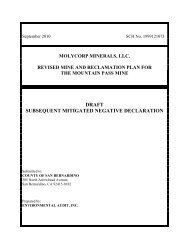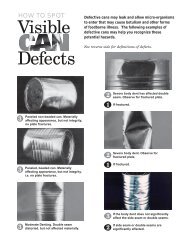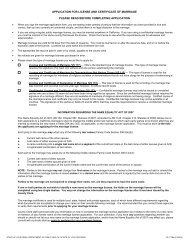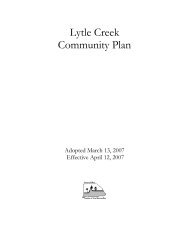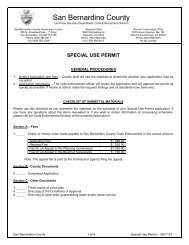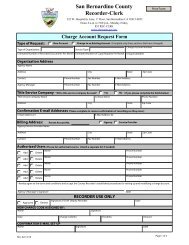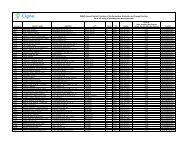textiles and fashions, 1860s—1960s A fashion timeline
textiles and fashions, 1860s—1960s A fashion timeline
textiles and fashions, 1860s—1960s A fashion timeline
Create successful ePaper yourself
Turn your PDF publications into a flip-book with our unique Google optimized e-Paper software.
The Fabrics of Our Past<br />
<strong>textiles</strong> <strong>and</strong> <strong><strong>fashion</strong>s</strong>, <strong>1860s—1960s</strong><br />
Contact: Jennifer Reynolds, media specialist, (909) 307-2660 • jreynolds@sbcm.sbcounty.gov<br />
Michele Nielsen, curator of history, (909) 307-2669 ext. 240 • mnielsen@sbcm.sbcounty.gov<br />
A <strong>fashion</strong> <strong>timeline</strong><br />
1860s—Women. Wide, very full skirts with hoops or cages; short waists <strong>and</strong> long, sloping, almost<br />
horizontal shoulders. Bodices fastened down the front with buttons; necklines for daytime<br />
were at the base of the neck, often with a small collar. Sleeves were wide <strong>and</strong> billowing <strong>and</strong><br />
wide belts were common. Hair was parted down the center <strong>and</strong> pulled tight behind the ears.<br />
During the Civil War, older garments were often altered. Men not in uniform wore loose-fitting<br />
coats that became shorter, narrower <strong>and</strong> with tighter sleeves as the decade progressed. Vests<br />
had narrow lapels <strong>and</strong> collars. Stiff shirt collars were for dress-up; everyday shirts had folddown<br />
collars. Beards were popular, <strong>and</strong> hair was parted on the side.<br />
1870s—Women. From 1870 to 1876, women wore a bustle at the back of the skirt, with the sides<br />
drawn in <strong>and</strong> back. About 1874 waistlines began to lengthen <strong>and</strong> two-piece dresses became<br />
the <strong>fashion</strong>, with a long jacket bodice (perhaps open over a vest) <strong>and</strong> separate skirt. Colors<br />
tended to be dark, <strong>and</strong> there was a plethora of pleating, ruffles, <strong>and</strong> flounces. Men’s jackets<br />
became closer-fitting, although loose jackets were worn casually.<br />
1880s—Women. Ready-made dresses became available for work or casual wear, <strong>and</strong> there<br />
were more style choices than before. After 1882, skirts became fuller, <strong>and</strong> in 1883 the bustle<br />
returned, peaking in 1886 <strong>and</strong> deflating in 1887, forming droopy, deep folds at the back of<br />
the skirt. Bodices were tight with high collars <strong>and</strong> narrow sleeves that ended short of the wrist.<br />
Men stopped wearing the loose “sack” coats; their fitted coats closed high at the throat, almost<br />
covering the necktie. Lapels were very narrow, as were the sleeves, <strong>and</strong> shirts were mostly<br />
white with a stiff or folding collar. Mustaches became popular.<br />
1890s—Women. At the start of the 1890s, tops of the sleeves at the shoulder had little puffs,<br />
exp<strong>and</strong>ing by 1892 to the upper sleeve <strong>and</strong> by 1893 to the tight wrist. By 1896 the leg ‘o<br />
mutton sleeve was at its most extreme. At the end of the decade, sleeves returned to a narrow<br />
shape with a shoulder puff. Women wore shirtwaists, <strong>and</strong> skirts were full in front, often from<br />
pleats <strong>and</strong> puffs. Men’s jackets got even shorter <strong>and</strong> narrower; the sleeves were so short the<br />
shirt cuff was exposed. Dress shirts were white, but work shirts varied in color. A hanging tie<br />
joined the popular bow tie.<br />
San Bernardino County Museum<br />
2024 Orange Tree Lane • Redl<strong>and</strong>s CA 92374 • (909) 307-2669 • www.sbcountymuseum.org<br />
—continues
A textile <strong>timeline</strong> (continued)<br />
1900s—Women. The <strong>fashion</strong> was for mature, sophisticated, well-bred ladies wearing flowing,<br />
organic forms that reflected the Art Nouveau style. Long full skirts gradually became narrower<br />
<strong>and</strong> shorter, eventually forming “hobble skirts” <strong>and</strong> offering glimpses of ankles. Haute couture<br />
fluorished in Paris <strong>and</strong> was sought after by the wealthy. The start of World War I in 1914<br />
brought a temporary end to <strong>fashion</strong> developments <strong>and</strong>, at the same time, introduced women<br />
to a much greater degree of freedom as they stepped into jobs once held by men who were<br />
now on the battlefields.<br />
1920s—Women began to liberate themselves from constricting clothing <strong>and</strong> undergarments<br />
<strong>and</strong> embraced more comfortable styles like pants <strong>and</strong> short skirts, although <strong>fashion</strong> remained<br />
conservative until about 1925. Then, revolutionary styles of the flapper era emphasized youth,<br />
hems rose to the knee, <strong>and</strong> waistlines disappeared.<br />
1930s—Women. Fashion became more conservative during the Great Depression. Skirts became<br />
longer <strong>and</strong> the waistline returned. Metallic lamé <strong>and</strong> rayon were glamorous evening fabrics,<br />
although <strong>fashion</strong> designers still preferred silk.<br />
1940s—Women. War once again influenced <strong>fashion</strong>, with cloth rationing <strong>and</strong> a restrained mood<br />
leading to drabness <strong>and</strong> uniformity. People “made do” by mending <strong>and</strong> repurposing clothing<br />
they already had. Rationing led to shorter skirts <strong>and</strong> boxy jackets; a maximum of three buttons<br />
per item of clothing was allowed. Nylon was scarce <strong>and</strong> women were encouraged to wear<br />
ankle socks with bare legs.<br />
1950s—Women. The “new look” at the end of World War II carried through the 1950s, with a<br />
return to luxurious fabrics, rounded shoulders, longer full skirts, <strong>and</strong> narrow waists, worn with<br />
ornate accessories. Hemlines changed every year, building obsolescence into mass-produced<br />
<strong>and</strong> couturier <strong>fashion</strong> typified by Christian Dior. The return of Coco Chanel offered elegant<br />
stability, but Paris was losing its premier <strong>fashion</strong> position as the first boutiques were created<br />
<strong>and</strong> Mary Quant designed her “Chelsea look.”<br />
1960s—Women. The decade was marked by a shift to ready-to-wear <strong>and</strong> an emphasis on<br />
youth <strong>and</strong> relatively cheap, throw-away <strong>fashion</strong> typified by “Swinging London.” Short skirts<br />
prevailed, although the maxi was introduced by Yves Saint Laurent at the end of the decade<br />
along with geometric sheaths, Pop Art <strong>fashion</strong>, <strong>and</strong> see-through blouses <strong>and</strong> dresses. The<br />
concept of “unisex” clothing was introduced by 1967, although women were more likely to<br />
wear pants suits than men were to don skirts.




